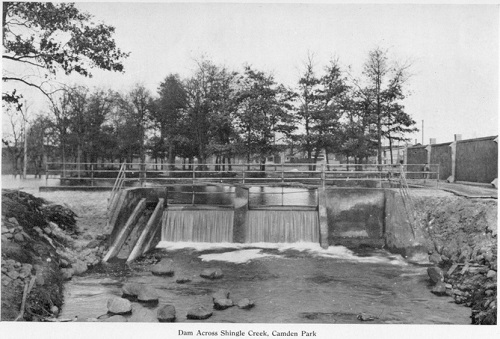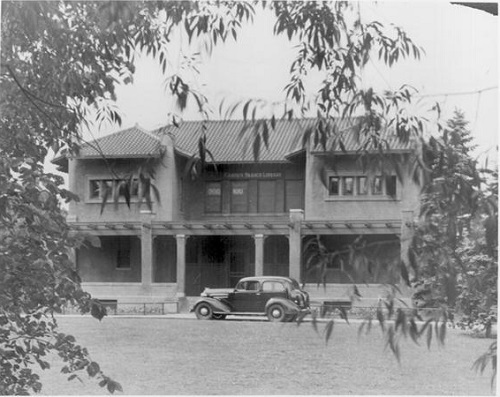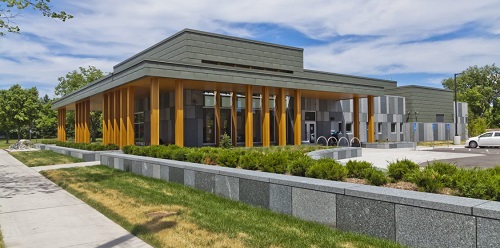A Creek, a Library, and a Pool
 Sunday, August 5, 2018 at 4:49PM |
Sunday, August 5, 2018 at 4:49PM |  Michael Rainville Jr |
Michael Rainville Jr | Article by Michael Rainville, Jr.
For six of the past seven years, the Minneapolis park system has been rated as the best in the U.S. A great example of this success is Webber Park in North Minneapolis. It has seen its ups and downs, but for over 100 years this park has been an important focal point in the Camden community.
 Second dam on Shingle Creek
Second dam on Shingle Creek
For almost twenty years the Minneapolis Park Board planned on acquiring land near the Mississippi River in Camden for a new park. As the need for a park in the area became more apparent, Superintendent Theodore Wirth and his colleagues gathered enough votes to establish a park along Shingle Creek. While the neighbors and businesses in the area were split 50/50 on the idea of having to pay for the new park, the foundation was in place. In 1909 Camden Park officially opened, with one of its key features being a pond that the park board put there by damming Shingle Creek. The nucleus of the park would be a new recreation building next to the pond, featuring a library on the 2nd floor. This was made possible by Charles and Mary Webber, who donated the money for the construction with three conditions. The building had to be named after their 9-year-old son, John Deere Webber, who had recently passed away, a new dam had to be built along the creek, and an outdoor playground had to be installed for the children of the neighborhood to enjoy. Charles Webber, who was the grandson of John Deere, owned and operated the Minneapolis branch of his grandfather’s company, which made it possible for his family to give back to the community by helping create one of the nicest parks in the city. It is because of the Webber’s contributions that Camden Park was renamed Webber Park in 1939.
The pool and pond quickly became a popular spot to cool off during the summer, and events such as log rolling contests and canoe races were a frequent sight at the park. The pollution that ran through the creek eventually became too much of a hazard, and in 1927 a new pool was made that used city water and filtration and chlorination systems. These upgrades saw its popularity rise, and in the 1930’s, as many as 1,400 children per day would use the pool during the Summer months. It wouldn’t be until 1979 when significant upgrades to the pool would be made again, with the most recent renovations coming in 2015. The current pool went back to its roots and used natural filtration from the creek and pond, thus making it the nation’s first public natural swimming pool when it reopened in on July 24th, 2015.
From 1910 to 1953, the library on the second floor of the recreation building was a huge hit for the children in the area. During the early years of the first iteration of the library, Ms. Countryman noted that “when [the children] are tired of playing they come up and settle down happily with their books. The library to them is one of their happy recreational spots, a feeling that is shared by their parents, who also participate in the community pleasures offered in the park." In 1953, the park board and library system came to an agreement to renovate the first floor of the recreation building so the library could expand.
 Original Webber Park Library
Original Webber Park Library
 Webber Park Library
Webber Park Library
The current Webber Park Library sits in a brand-new building that opened just over a year ago in May of 2017. This came after a 17-year debate about what to do with the old library. Renovate it or build a new one? The new library is once again a place where children can go once they tire themselves out from a long day of swimming and playing, and is a state-of-the-art facility that will without a doubt contribute to the growth of the community.
While buildings, park equipment, and other amenities have been replaced throughout the long history of the park, one thing has stayed the same, and that is the importance it holds within the Camden community. For over 100 years people have enjoyed the trails, fields, pool, and library of Webber Park, and in this constantly changing world, it is always nice to have an anchor in this community that never fails to spread peace, joy, and love to everyone who calls North Minneapolis their home.
- - - - - - - - - - - - - - - - - - - - - - - - - - - - - - - - - - - - - -
 About Michael Rainville, Jr.
About Michael Rainville, Jr.
A 6th generation Minneapolitan, Michael Rainville Jr. received his B.A. in History from the University of St. Thomas, and is currently enrolled in their M.A. in Art History and Certificate in Museum Studies programs.
Michael is also a lead guide at Mobile Entertainment LLC, giving Segway tours of the Minneapolis riverfront for 5+ years.
He can be reached at mrainvillejr@comcast.net.
